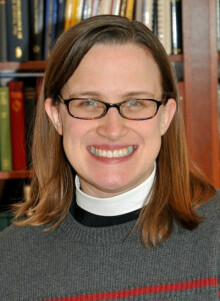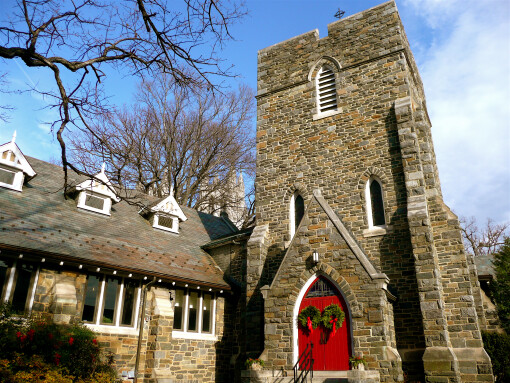Blind Spots (2)

Series: Epiphany
Speaker: The Rev'd Emily Griffin
Is this what he meant? Mary had to wonder. We don’t know if she was there for the events relayed in today’s Gospel, but it’s a fairly safe assumption. What Jewish mother wouldn’t be there for her son taking center stage at their hometown synagogue? Seeing him standing there, reading from Isaiah – maybe she flashed back to the first time she took him to an official house of worship. When he was just 40 days old, she and Joseph brought him to the temple in Jerusalem. Old Simeon took one look at him and knew exactly who he was. We remember this moment every February 2nd on a feast called Candlemas (yes, February 2 – also known as yesterday – it’s more than just Groundhog Day.) Anyone who’s ever sung or listened to Evensong is familiar with Simeon’s most famous lines – known as the Nunc Dimittis. He calls this infant “a light to enlighten the nations and the glory of your people Israel.” Not sure how he knows that – it’s not like Jesus could talk or walk or do much of anything at that point to warrant such praise. But then Simeon goes on and warns Mary: “This child is destined for the falling and the rising of many in Israel, and to be a sign that will be opposed so that the inner thoughts of many will be revealed.” Is that what was happening now?
Maybe Mary flashed back to that moment as she watched her neighbors try to throw her son off a cliff. It all started innocently enough. Jesus had recently come back from a 40-day stint in the desert. Something about finding himself, he told her. He’d been testing out his message in nearby Capernaum, but now it was time to try it on the folks back home. These were the people who watched him grow up, who taught him Hebrew. They’d helped to launch him as a young adult, and now it was time for him to make them proud, or so they thought.
He starts by reading one of Isaiah’s more lofty passages, about how the Spirit of the Lord has anointed him to bring good news to the poor, freedom from oppression, recovery of sight to the blind. When Jesus tells the crowd that today that Scripture’s been fulfilled in their hearing, no one’s upset at first. No one seems concerned, at least not yet, that he’s developing a Messiah complex. If only he could have left it there, Mary told herself. But no – he has to poke them with a stick, point out their blind spots, remind them that when he says “poor and oppressed,” he means more than just them.
The people of Nazareth weren’t wrong to think of themselves as poor and oppressed. They weren’t inventing their pain. They did live in a rural backwater, far from the seat of power, undeniably subject to the whims of a distant central government. And no - they weren’t wrong to believe that the good news Jesus was announcing could actually be good news for them.
They just weren’t prepared for it to be addressed to the ones they thought of as “line cutters.” (A credit to Arlie Russell Hochschild and her book Strangers in Their Own Land for this image.) The line cutters were, in this case, those Gentiles who didn’t wait their turn, who didn’t earn their spot in line like the folks in the synagogue had with their stellar attendance and adherence to the law. The fact that Jesus brought up the widow of Zarephath and Naaman the Syrian – two Gentiles who received God’s favor and healing while hungry and sick Israelites were seemingly left out in the cold – it was like waving a red flag in front of a bull. It reminded them too much of the present.
It wasn’t necessarily that the widow and Naaman were Gentiles; the synagogue likely had Gentile patrons. These folks from Nazareth knew of non-Jews who feared God, who prayed in the outer court when they visited the temple. They didn’t have a problem with those Gentiles, the ones who knew their place and showed the proper deference. It was the idea that God’s grace could be offered to those who didn’t even know to ask for it, who hadn’t studied the Scriptures like they had, who hadn’t yet thought their way to a reasoned faith. All that the widow had done to warrant the prophet’s attention was get hungry; all Naaman had done was get sick. It wasn’t fair. So instead of waiting for Jesus to complete his thought, instead of listening past the sound byte, they let their anger at anticipated injustice that was already at the surface boil over onto the most convenient target.
Sound familiar? We too live in an era of instant outrage. Sometimes it’s warranted, sometimes not. It’s hard to tell, though, when the alarms are always sounding. We draw the lines differently, of course. Ours might not be between Jew and Gentile; ours might be along other religious or socioeconomic lines or, in this town particularly, party lines - NPR vs. Fox News fans. Whatever lines we’ve drawn, we don’t like when Jesus erases them. We don’t like when it feels like someone has cut in line ahead of us, when they’re simply given what we feel we’ve had to earn – whether it’s citizenship or income or God’s favor. We might not realize how strong our feelings are until the Scriptures reveal our blind spots – that the objects in our mirrors are closer than they appear.
Perhaps it’s because I work with children regularly that I noticed another blind spot revealed by our readings. One of the reasons the folks in the synagogue turned on Jesus so easily was precisely because they’d known him as a child. They remembered when he couldn’t keep still in worship, when he was vulnerable and inexperienced and needed their protection – and that diminished him in their eyes. Simeon may have been able to see light and glory in this child’s face, but his friends and neighbors couldn’t – even after he’d grown up. They didn’t connect Jesus’ call to the call Jeremiah received as a boy. They’d forgotten, as our psalmist reminds us - and as I know from my own life and from working with our kids, that it’s possible for children to hope and trust fully in God as children, to know in their bodies and spirits what they can’t yet articulate with their minds. They’d fallen into the trap that St. Paul appears to have fallen into in his otherwise masterful depiction of love in 1st Corinthians 13. They’d equated childhood merely with immaturity, with incompleteness – forgetting that children are just as capable of reflecting the love and image of God as any fully-grown adult.
This can be a blind spot in our community too, particularly in our worship. We too can fall into the trap of thinking that we belong in a way that children don’t – that we’ve somehow earned our spot with our good behavior and our inside voices, with our ability to think and talk our way to faith – forgetting that God’s grace is equal opportunity. Sure, there are things children need to learn as they worship, about making space and silence for others. But adults need to learn that too. The presence of children in our pews and at our altar reminds us that it’s not our accomplishments or our cleverness that bring us here; it’s our common dependence on a grace that transcends us all.
In the silence that follows, I invite us all to consider our triggers for instant outrage and where they really come from, the lines we’ve drawn that Jesus has erased – whether it’s by age or income or party or chosen news source. Yes, of course, God loves us blind spots and all, but God loves us too much to let us keep them. In the Name of the One who insists on bringing recovery of sight to the blind, whether we like it or not – Amen.
 Welcome to St. Alban’s Church! Every Sunday, and most days in between, people gather in this place to worship, to learn, to grow, to share the joys and struggles of our lives, and to seek God’s grace in the midst of our lives. We do not come because we have it all figured out, but because we are seeking light on the way. We come as we are and welcome one another.
Welcome to St. Alban’s Church! Every Sunday, and most days in between, people gather in this place to worship, to learn, to grow, to share the joys and struggles of our lives, and to seek God’s grace in the midst of our lives. We do not come because we have it all figured out, but because we are seeking light on the way. We come as we are and welcome one another.

